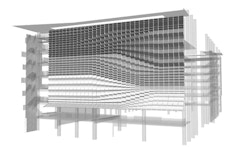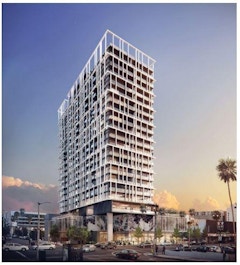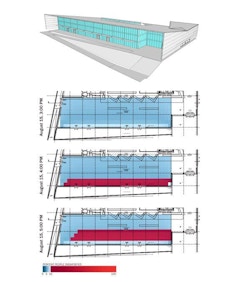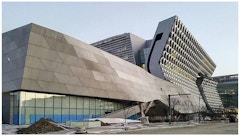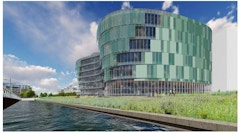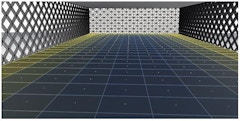
31 results
-
 The method proposed is derived from a parametric workflow that employs the precision of 6-axis robots and the flexibility of fabric to rapidly create…
The method proposed is derived from a parametric workflow that employs the precision of 6-axis robots and the flexibility of fabric to rapidly create… -

Climate-Oriented Prefabricated Building Envelopes
- Paper by Sridharan Gandhi, Andrew Tsay Jacobs, AIA, EIT, LEED AP BD+C, Karen Kensek, Assoc. AIA, LEED AP BD+C,
Facades developed in response to climactic factors increase performance and human comfort while reducing energy loads. A single building envelope… -
Towards A Data Driven Fabrication Process
- Paper by Becher Neme · Michael Kilkelly
Today's evolving digital tools allow designers to be more creative in designing new forms and geometries. Adapting similar tools to the fabrication
-

Thermal Comfort Assessment of Multi-Zone Electrochromic Window
- Paper by Ahoo Malekafzali, Ph.D.,
Access to natural daylight and connection to the outdoor environment is one of the key elements of contemporary architecture. This design concept is… -

Seismic Movements
- Paper by Gijs Libourel, Daniel Segraves,
A common building upgrade to add value to existing commercial real estate is the renewal of the entrance lobby. The lobby facade is replaced to give… -

Performance Based Generative Facade Workflow for Large Scale Projects
- Paper by Paul Ferrer · Mili Kyropoulou · Tim Logan · Heath May · James Warton
Over the last two decades, in what has been coined “The Digital Turn”, the introduction of parametric design software has afforded increased
-

Origami-Inspired Facade Design
- Paper by Joshua Schultz, Ph.D, P.E., LEED AP, ENV SP, Neil Katz, AIA,
To paraphrase Robert le Ricolias, the art of the structure is where to put the folds. Using that inspiration, fundamental concepts from origami,… -

Orbit Tower
- Paper by Enrica Oliva, Michele Andaloro, Werner Sobek,
While most of high-rise buildings feature a core surrounded by a spatial frame defining the volume, one could envision a column-free plan where the… -

Novel Techniques for Facade Optimization
- Paper by Viktoria Henriksson,
Complex freeform architectural enclosures are becoming increasingly popular and easy to model and design with the help of modern computational tools.… -
Integrated Energy Analysis
- Paper by Greg Verabian · Saurabh Shrestha · Laure Michelon
Energy codes across the country are progressively getting stricter and increasing the threshold for a baseline building’s energy performance.
-
Emulating Nature's Structured Randomness in Facade Design
- Paper by Ned S. Kirschbaum FAIA, CCCA, LEED AP BD+C
The wonder of nature is the abundance of unique forms she creates based on a few simple physical principles or laws. No two snowflakes are alike.
-
Direct Sun and Occupant Comfort
- Paper by Madeline Gradillas · Henry Richardson
Direct sun on the body is a known potential cause of thermal discomfort for occupants, yet most thermal comfort simulations do not capture its
-
Design Digital Recipes
- Paper by Trevor Stephen Lewis, PhD, PE · Lukasz Blonski · Jessica Chen, PE
Precision in digital workflow is necessary to deliver facade projects where there is a high design aesthetic or structural performance requirement.
-
Design Considerations and the Complex Facade
- Paper by Stan Su
The design of complex, high-performance facades involves balancing attention towards principles of material selection, thermal and moisture
-
DC Water Headquarters Case Study
- Paper by Sven Shockey · Leland Curtis · David Fersh
Facades must be responsive to a myriad of qualities and influences ranging from urban impact and aesthetic character to numerous performance
-
Daylighting Parametric Workflows Used for Adaptive Reuse
- Paper by Alfonso E. Hernandez, AIA, NCARB, LEED BD+C
Daylighting & Solar Glare control, which affect both the energy consumption of the building as well as the comfort of the occupants, become
-

Architectural Ceramic Assemblies
- Paper by Omar Khan, Bill Pottle, Mitchell Bring,
This paper documents a six year academia/industry collaboration between researchers at the Department of Architecture, University at Buffalo (SUNY)… -
Algorithmic Patterns for Facade Design
- Paper by Inês Caetano · António Leitão
Recently, building envelopes have been exhibiting complex shapes and patterns, a trend supported by current digital technologies. Likewise, the
-
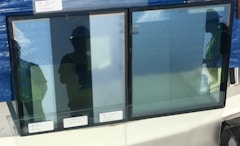
Solar Reflection Mitigation
- Paper by Kais Al-Rawi, AIA
Glass by nature is a reflective material, and it is well-known and documented that issues of glare can occur due to solar reflection. This phenomenon
-

Circadian Daylight Performance of the Electrochromic Glazing
- Paper by Ahoo Malekafzali. PhD., Sr. Technical Solutions Consultant
Electrochromic windows introduced to building market as a smart glare control solution to provide visual comfort for building occupant. EC glazing…
